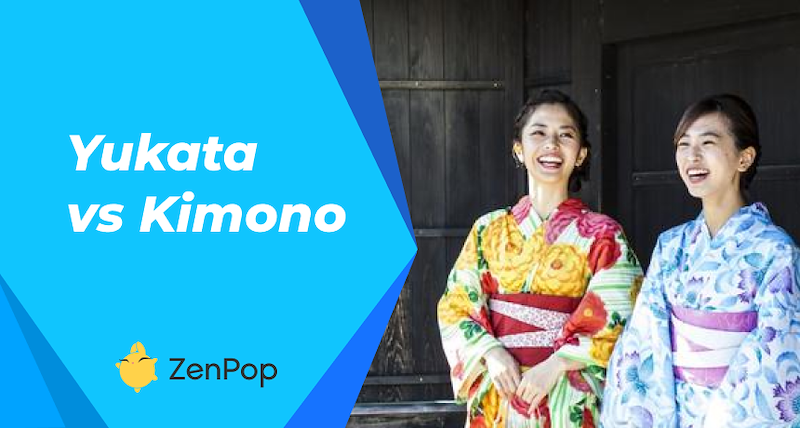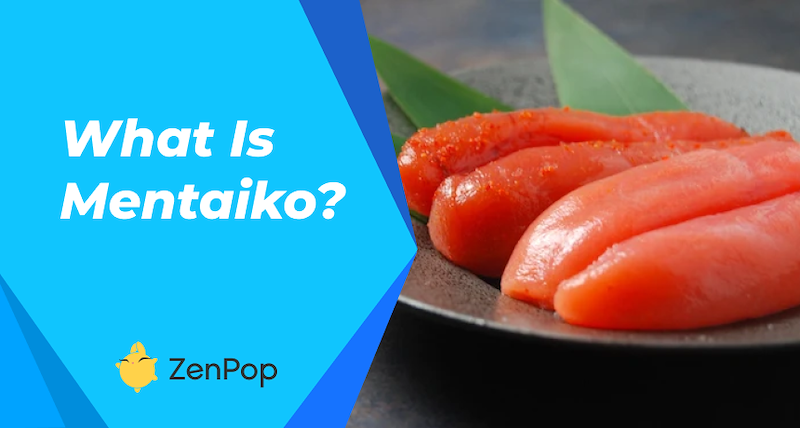
</title><meta name="robots" content="noindex"> What is Mentaiko, Japanese Cod Roe?
With its unique taste and texture, Mentaiko has become a go-to ingredient in many Japanese dishes, including sushi, rice bowls, and noodles. In this article, we'll explore what exactly Mentaiko is, how it's made, and how it can be used in your own cooking. Whether you're a seasoned sushi lover or a curious foodie looking to try something new, read on to discover the fascinating world of Mentaiko.
What is Mentaiko?
Mentaiko is a traditional Japanese seafood made out of pollock or cod roe which are basically fully formed fish eggs. The roe is salted, seasoned with spices such as red pepper, and then fermented. The finished product is a bright orange or pink color and has a unique spicy, salty, and slightly sweet taste.
Fun fact! “Mentaiko" is a Japanese word that means "bright prince". It is assumed that the name was given to the dish mainly as a result of its vibrant orange or pink color, which is similar to the robes worn by ancient Japanese princesses.
Mentaiko is often served as a dressing or topping for rice, noodles, and other dishes. It can also be enjoyed on its own as a snack. There are many different types of Mentaiko, with several levels of spiciness and flavor. Some brands also add other ingredients such as soy sauce or vinegar to the marinade which gives it the extra kick!
In Japanese cuisine, Mentaiko is a famous ingredient in many conventional dishes such as Mentaiko spaghetti/ Mentaiko pasta, Mentaiko onigiri (rice balls), and Mentaiko udon.
History of mentaiko
Although it is a popular Japanese meal, Mentaiko did not actually originate in Japan. It is believed to have originated in Korea where it is known as myeongran jeot made from fermented pollock roe. It was later introduced to Japan in the early 20th century by Korean immigrants who settled in the Fukuoka region of southern Japan. The immigrants began making Mentaiko using locally caught pollock roe, which was abundant in the waters around Fukuoka.
At the beginning of the Taisho era, many Japanese people who resided in Korea began to develop a liking for it, and by the 1940s, it had become popular and spread throughout Japan. During World War II, when rice was scarce, Mentaiko became a popular substitute, as it was both filling and nutritious. Soon after the world war had ended, the production of the dish commenced and gained even more popularity in Japan.
In the 1950s and 1960s, the introduction of refrigerator technology made it convenient for the transportation of Mentaiko to other regions of Japan, thus increasing its popularity once again.
How to make mentaiko?
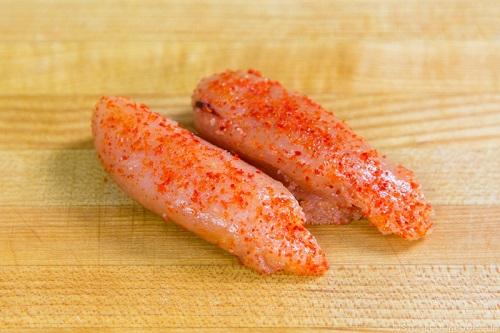
Making Mentaiko is a lengthy process but straightforward. It is all about getting the spices right. The first step is to salt the fresh cod/pollock roe, which draws out moisture and helps to preserve it. After that, it is then rinsed and coated in a mixture of spices like chili, sake, yuzu citrus, and konbu all of which gives it a mixture of sweetness, sourness, and hotness. The roe is then left to marinate for several days, allowing the flavors to penetrate and infuse the roe. When this is done, Mentaiko gets the signature orange hue and it is ready to be packaged. The final product is a spicy and flavorful delicacy that can be enjoyed in a variety of ways.
One more thing, the redness of the Mentaiko is an indication of how spicy it is. Most packages will have the word “karashi” to warn you so check the ingredients carefully before buying. Mentaiko is regarded as a weird meal outside Japan, read our article on the weirdest foods in Japan to learn about other weird combinations.
Mentaiko vs Tarako
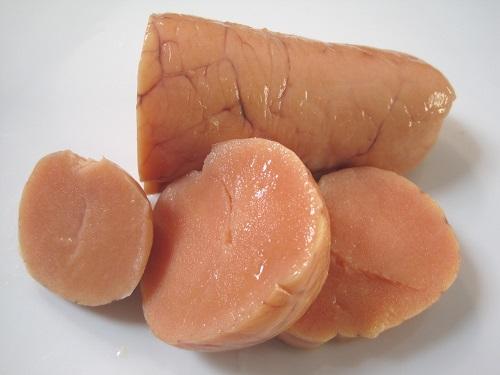
While Mentaiko and tarako are both made from fresh cod roe, there are several key differences between these two ingredients. The first difference is in the curing process. Mentaiko is marinated in a mixture of salt and a mixture of spices, giving it a bright color and flavorful taste. Tarako, on the other hand, is simply salted and dried, giving it a milder flavor.
Another difference between Mentaiko and tarako is their appearance. Mentaiko is bright orange in color, while tarako is a pale pink or white color. This difference in color is due to the curing process, with Mentaiko being infused with red pepper and tarako being left in its natural state. Also, the texture of Mentaiko and tarako is different. Mentaiko is softer and creamier in texture, while tarako is drier and more crumbly.
The mentaiko Taste and Flavor
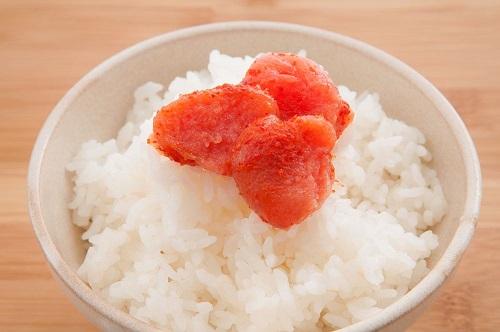
Now if you haven't tried Mentaiko for the first time you might be curious, “What does it taste like?” “Will I enjoy it?” well we can't say because we all have our preferences, however, here's a swift summary of what you are likely to taste when having Mentaiko.
The prominent flavors of mentako are salty, spicy, and slightly sweet respectively. The saltiness comes from the curing process, while the spiciness is from the chili peppers and the sweetness is gotten from the mirin (sweet rice wine) used in the marinade process. In conclusion, the flavor of Mentaiko is savory and bold, with a distinctive umami taste. It has a slightly chewy texture, and the individual eggs in the roe are small and firm to bite.
What are some interesting facts about mentaiko?
- Mentaiko is rich in protein and omega-3 fatty acids, and vitamin B12. Making it a nutritious food. However, it is also high in sodium, so it should be consumed in moderation.
- The most common type of fish roe used to make Mentaiko is pollock roe, but cod roe is also sometimes used. The roe is typically harvested during the winter months when the fish are at their fattest.
- There is usually confusion between Mentaiko and tarako. Tarako is made from untreated fish roe, and has a milder flavor and a softer texture than Mentaiko, Mentaiko is basically marinated tarako.
- Mentaiko has a long shelf life and can be stored in the refrigerator for several months.
- In Japan, Mentaiko is often served as a drinking snack which makes it a good blend for taking sake or alcohol.
- The city of Hakata in Fukuoka Prefecture, Japan, is famous for its Mentaiko production. The city produces over 60% of all Mentaiko in Japan.
Mentaiko Recipes
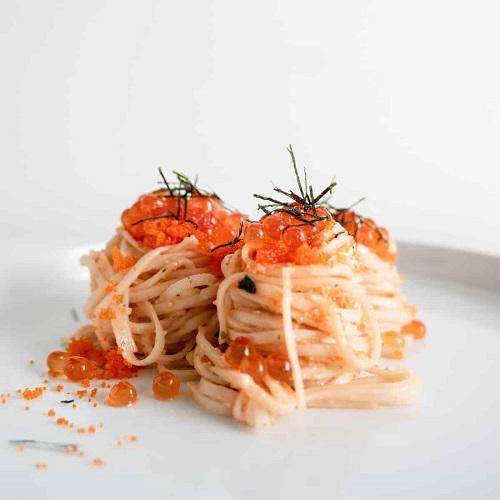
When it comes to Mentaiko, always remember that it has versatility so it can be enjoyed in several ways. Be creative when it comes to your meals you never know what explosion of flavors you may be creating. Anyways, here are a few ways Mentaiko can be enjoyed in meals:
- Mentaiko can be used as a topping for rice: sprinkle some Mentaiko over a bowl of steaming rice and enjoyed a nice hot meal
- Spread on toast: Mentaiko toast is a famous Japanese breakfast, just spread the Mentaiko on a piece of toasted bread and enjoy.
- In soups: including Mentaiko in soups such as miso can add a salty savory touch to the soup.
- In Sushi rolls: Mentaiko can totally be added as a filling in sushi, it adds a unique taste that is quite enjoyable.
- In pasta: now I'm sure we're all lovers of pasta! If you're not then I strongly advise adding some Mentaiko to your pasta dish. Simply mix the Mentaiko with cooked pasta, butter, and soy sauce, and you'll have an amazing meal.
Would you be interested in trying Mentaiko? Feeling a little hungry? We know we are. Don’t worry, we’ve got you covered. Discover our ZenPop Snack box and get it anywhere in the world.
This article was originally written by our freelance writer Umm-Kulthum Abdulkareem and edited by us.


